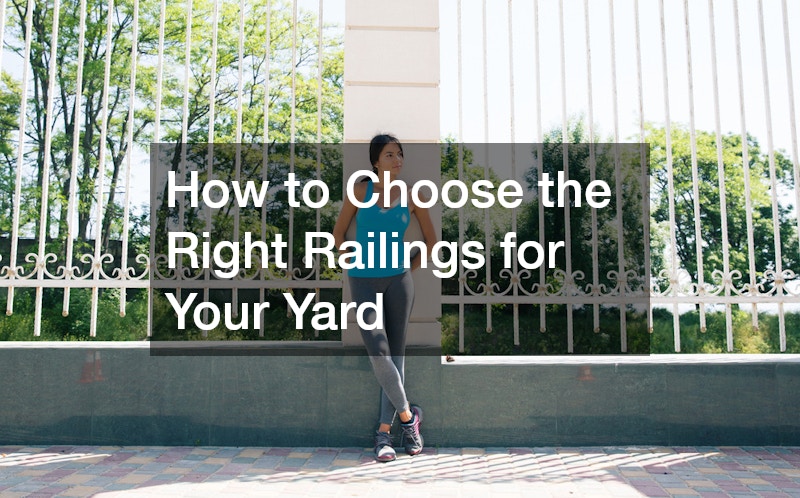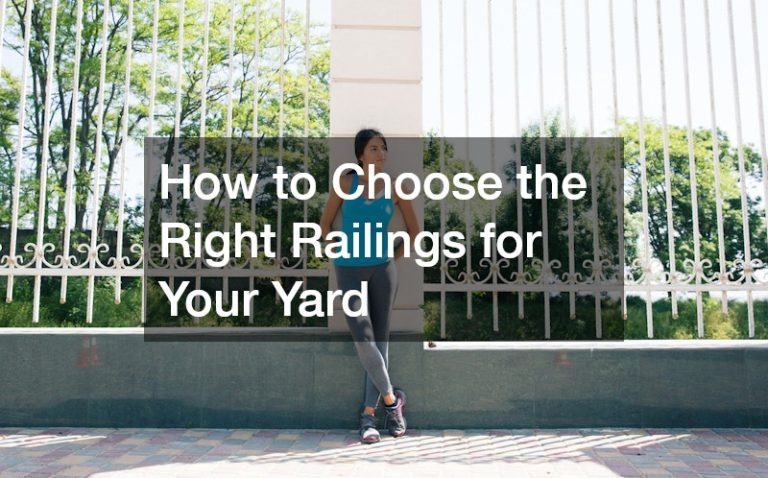
Choosing the right railings for your yard can significantly impact your outdoor space’s appearance and functionality. Railings provide more than just a boundary—they can add a decorative touch, improve safety, and enhance the overall value of your property. Because they come in various styles, materials, and designs, selecting the perfect option requires thoughtful consideration.
Whether your yard is meant for entertaining guests, offering a safe play space for children, or simply creating a private retreat, railings can tie the entire look together while meeting your practical needs.
A well-chosen railing will complement your home’s architectural style, endure outdoor weather conditions, and meet any safety requirements that may apply. Each choice from traditional wood to modern metal or composite designs has unique benefits and challenges. By carefully evaluating the key factors involved—such as design harmony, material durability, cost, and maintenance—you can confidently decide to balance style with function for years to come.
Understanding Your Yard’s Style
One of the first considerations when selecting railings is their integration with your yard’s design and style. Your outdoor space is an extension of your home, so the railings you choose should feel like a natural part of the overall look. This includes considering color palettes, architectural features, and landscaping elements. A railing design that complements your home’s rustic or modern style can help create a seamless, cohesive appearance.
For example, if your yard features many natural elements such as stone pathways, wooden furniture, and lush greenery, a wooden railing with a natural finish could blend beautifully. On the other hand, a sleek, minimalist yard with clean lines and geometric landscaping might be better suited for powder-coated aluminum railings in a neutral color. By identifying the existing style cues in your yard and home, you can choose a railing that enhances rather than competes with the overall aesthetic.
Considering Safety and Durability Requirements
Railings play a vital role in ensuring the safety of your yard, particularly if you have elevated areas like decks, patios, or stairs. The height, spacing between balusters, and strength of the railing must comply with safety guidelines to prevent accidents. Durability is equally important, as railings will be exposed to weather conditions like rain, snow, and intense sunlight. A railing that meets both safety standards and is built to last will provide peace of mind while reducing the need for frequent repairs.
In more specific terms, if you have young children or pets, selecting a railing with closely spaced balusters can help prevent slips or falls. Materials such as stainless steel, composite, or treated wood can resist rotting, rust, and warping in areas exposed to harsh climates. If your region experiences strong winds, choosing railings with sturdy anchoring systems can keep them stable and secure. Thinking about these factors early in the process ensures your railings are both safe and resilient.
Exploring Material and Maintenance Options
The material you choose for your railings will affect their appearance and long-term maintenance needs. Common materials include wood, vinyl, metal, and composite, each offering advantages and drawbacks. Wood provides a timeless, natural look but may require regular sealing or staining to maintain its appearance. Vinyl offers low maintenance and weather resistance, while metal can deliver strength and a modern style. Composite combines the best of both worlds, offering the look of wood with the durability of synthetic materials.
For instance, cedar or redwood could be excellent choices if you prefer a warm, organic aesthetic and don’t mind occasional upkeep. If low maintenance is your top priority, vinyl or powder-coated aluminum may be the better option, as they resist fading and corrosion. Composite railings, while typically more expensive upfront, can provide a long lifespan without extensive care, making them a practical choice for busy homeowners. Weighing these trade-offs will help you select a material that fits your lifestyle and design vision.
Matching Railings to Your Budget
Budget is essential when deciding on the proper railings for your yard. Costs vary widely depending on the material, style, and installation complexity. It’s important to determine your budget range early and then explore the options available within it. Remember that the lowest price isn’t always the best value—railings that require frequent repairs or replacements can cost more over time.
For example, pressure-treated wood railings may be more affordable initially but could require ongoing maintenance that adds to the total cost. Conversely, stainless steel or composite railings may have a higher upfront price but offer years of durability with minimal upkeep. If your budget is tight, consider blending materials—such as a metal frame with wooden balusters—to achieve cost savings and aesthetic appeal. Comparing short-term and long-term expenses will help you make a financially wise decision.
Selecting the proper railings for your yard involves balancing style, safety, durability, budget, and expert advice. The best choice will enhance the visual appeal of your outdoor space and serve as a reliable and safe feature for years to come. By evaluating your yard’s design, considering material and maintenance requirements, and setting a clear budget, you can make an informed decision that meets both aesthetic and practical needs.





